2013 TOYOTA TACOMA tire pressure
[x] Cancel search: tire pressurePage 3 of 28
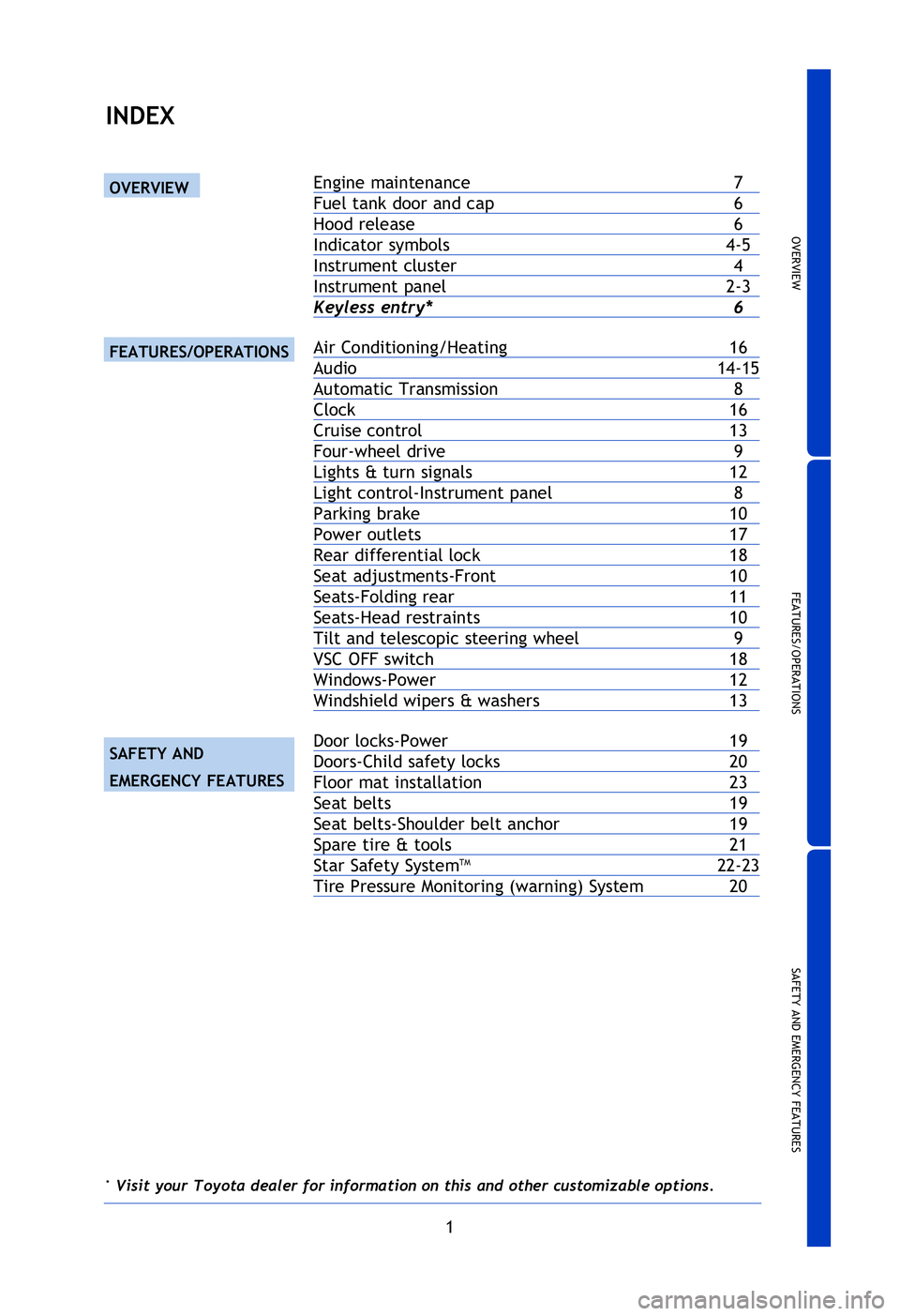
OVERVIEW
FEATURES/OPERATIONS
SAFETY AND EMERGENCY FEATURES
1
2013
TacomaINDEX
Engine maintenance 7
Fuel tank door and cap 6
Hood release 6
Indicator symbols 4-5
Instrument cluster 4
Instrument panel 2-3
Keyless entry* 6
Air Conditioning/Heating 16
Audio 14-15
Automatic Transmission 8
Clock 16
Cruise control 13
Four-wheel drive 9
Lights & turn signals 12
Light control-Instrument panel 8
Parking brake 10
Power outlets 17
Rear differential lock 18
Seat adjustments-Front 10
Seats-Folding rear 11
Seats-Head restraints 10
Tilt and telescopic steering wheel 9
VSC OFF switch 18
Windows-Power 12
Windshield wipers & washers 13
Door locks-Power 19
Doors-Child safety locks 20
Floor mat installation 23
Seat belts 19
Seat belts-Shoulder belt anchor 19
Spare tire & tools 21
Star Safety System
TM 22-23
Tire Pressure Monitoring (warning) System 20
OVERVIEW
FEATURES/OPERATIONS
SAFETY AND
EMERGENCY FEATURES
* Visit your Toyota dealer for information on this and other customizable \
options.
126906_GUTS.indd 17/20/12 10:48 PM
Page 4 of 28
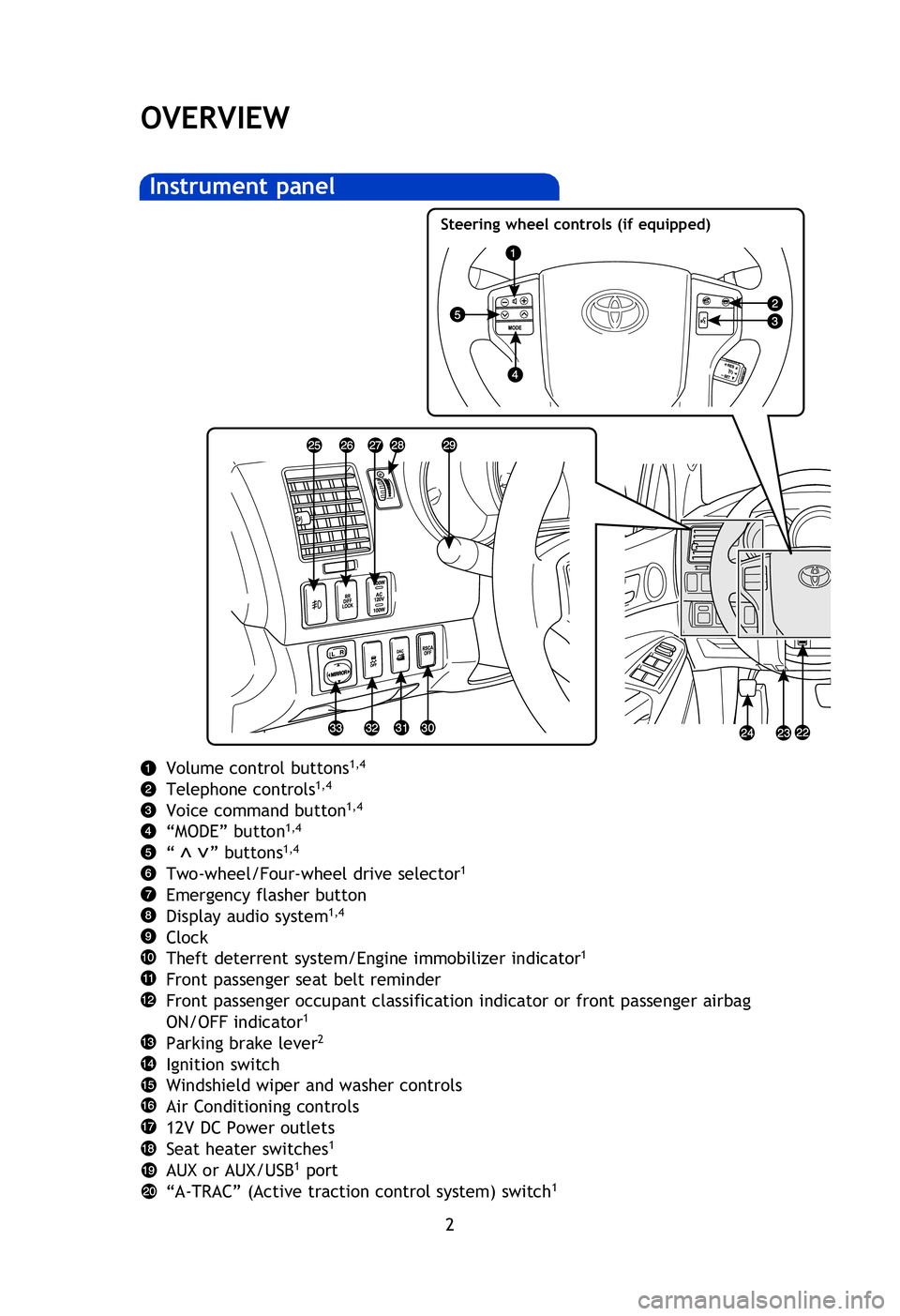
2
OVERVIEW
Volume control buttons1,4
Telephone controls1,4
Voice command button1,4
“MODE” button1,4
“ ” buttons1,4
Two-wheel/Four-wheel drive selector1
Emergency flasher button
Display audio system1,4
Clock
Theft deterrent system/Engine immobilizer indicator1
Front passenger seat belt reminder
Front passenger occupant classification indicator or front passenger airbag
ON/OFF indicator
1
Parking brake lever2
Ignition switch
Windshield wiper and washer controls
Air Conditioning controls
12V DC Power outlets
Seat heater switches
1
AUX or AUX/USB1 port
“A-TRAC” (Active traction control system) switch1
Cruise control1
Tilt and telescopic steering lock release lever
Tire Pressure Monitoring (warning) System reset
Parking brake pedal
3
Front fog light switch1
Rear differential lock switch1
120V AC Power outlet ON/OFF switch1
Instrument panel light control
Headlight and turn signal controls
“RSCA OFF” (Roll Sensing Curtain shield Airbags OFF) switch
1
“DAC” (Downhill Assist Control) button1 or clutch start cancel switch1
Vehicle Stability Control OFF switch
Power rearview mirror control switches1
1 If equipped2 Manual Transmission only3 Automatic Transmission only4 For details, refer to “Display Audio System Owner’s Manual .”
NOTE: For vehicles equipped with Entune
TM, please consult the “Navigation
System With Entune Quick Reference Guide” or www.toyota.com/entune.
Instrument panel
Steering wheel controls (if equipped)
>>
126906_GUTS.indd 27/20/12 10:49 PM
Page 5 of 28
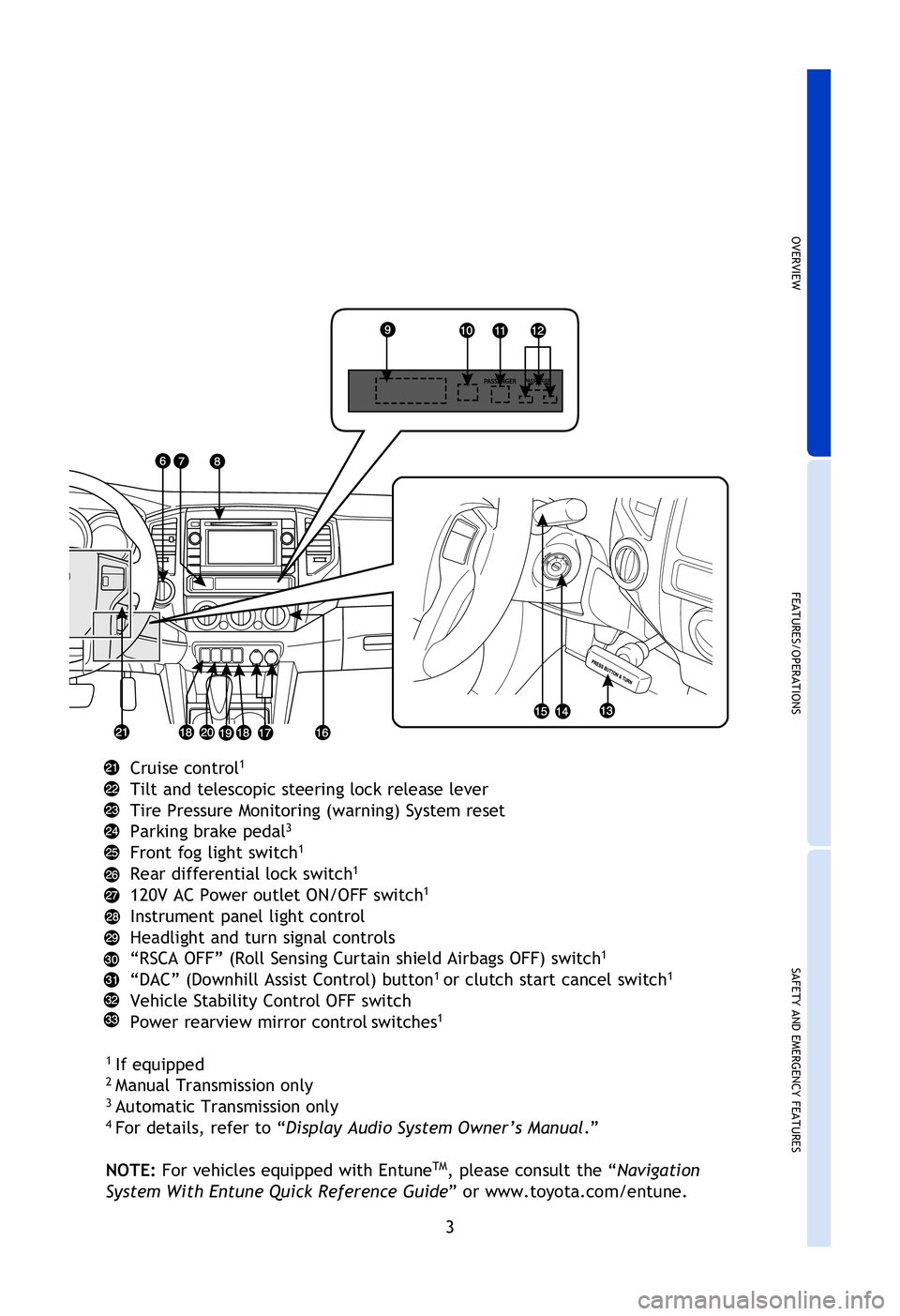
OVERVIEW
FEATURES/OPERATIONS
SAFETY AND EMERGENCY FEATURES
3
Volume control buttons1,4
Telephone controls1,4
Voice command button1,4
“MODE” button1,4
“ ” buttons1,4
Two-wheel/Four-wheel drive selector1
Emergency flasher button
Display audio system1,4
Clock
Theft deterrent system/Engine immobilizer indicator1
Front passenger seat belt reminder
Front passenger occupant classification indicator or front passenger airbag
ON/OFF indicator
1
Parking brake lever2
Ignition switch
Windshield wiper and washer controls
Air Conditioning controls
12V DC Power outlets
Seat heater switches
1
AUX or AUX/USB1 port
“A-TRAC” (Active traction control system) switch1
Cruise control1
Tilt and telescopic steering lock release lever
Tire Pressure Monitoring (warning) System reset
Parking brake pedal
3
Front fog light switch1
Rear differential lock switch1
120V AC Power outlet ON/OFF switch1
Instrument panel light control
Headlight and turn signal controls
“RSCA OFF” (Roll Sensing Curtain shield Airbags OFF) switch
1
“DAC” (Downhill Assist Control) button1 or clutch start cancel switch1
Vehicle Stability Control OFF switch
Power rearview mirror control switches1
1
If equipped2 Manual Transmission only3 Automatic Transmission only4 For details, refer to “Display Audio System Owner’s Manual .”
NOTE: For vehicles equipped with Entune
TM, please consult the “Navigation
System With Entune Quick Reference Guide” or www.toyota.com/entune.
126906_GUTS.indd 37/20/12 10:49 PM
Page 7 of 28
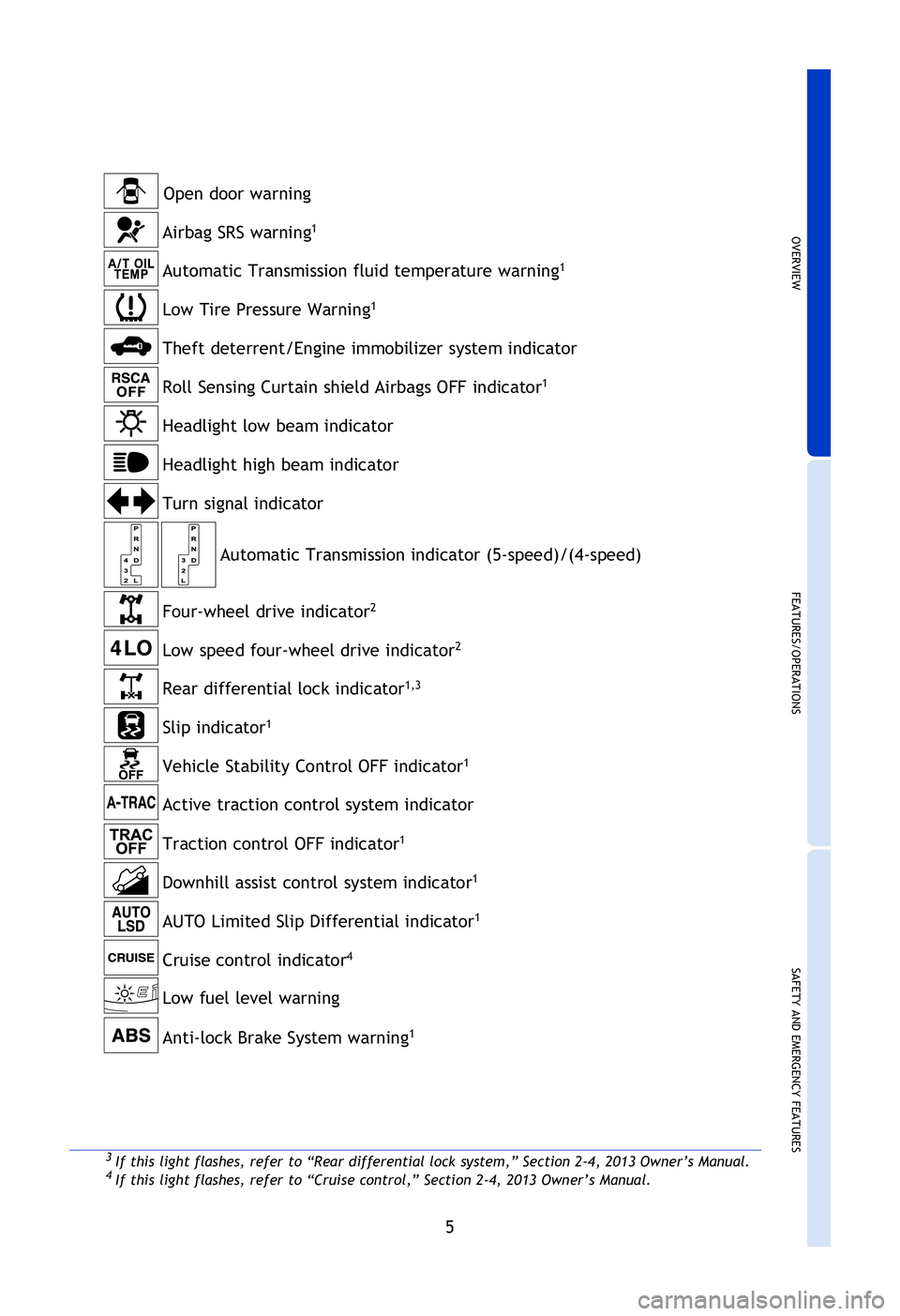
OVERVIEW
FEATURES/OPERATIONS
SAFETY AND EMERGENCY FEATURES
5
Open door warningAutomatic Transmission indicator (5-speed)/(4-speed)
Low fuel level warning
Headlight low beam indicator
Headlight high beam indicator
Turn signal indicator
Four-wheel drive indicator
2
Low speed four-wheel drive indicator2
Rear differential lock indicator1,3
Slip indicator1
Vehicle Stability Control OFF indicator1
Downhill assist control system indicator1
AUTO Limited Slip Differential indicator1
Cruise control indicator4
Automatic Transmission fluid temperature warning1
Low Tire Pressure Warning1
Theft deterrent/Engine immobilizer system indicator
Airbag SRS warning1
Roll Sensing Curtain shield Airbags OFF indicator1
1 If indicator does not turn off within a few seconds of starting engine, there may be a
malfunction. Have vehicle inspected by your Toyota dealer.
2 If this light flashes, refer to “Four-wheel drive system,” Section 2-4, 2013 Owner’s Manual.
3 If this light flashes, refer to “Rear differential lock system,” Section 2-4, 2013 Owner’s Manual.4 If this light flashes, refer to “Cruise control,” Section 2-4, 2013 Owner’s Manual.
Active traction control system indicator
Anti-lock Brake System warning
1
For details, refer to “Indicators and warning lights,” Section 2-2, 2013 Owner’s
Manual .
Traction control OFF indicator1
126906_GUTS.indd 57/20/12 10:49 PM
Page 22 of 28
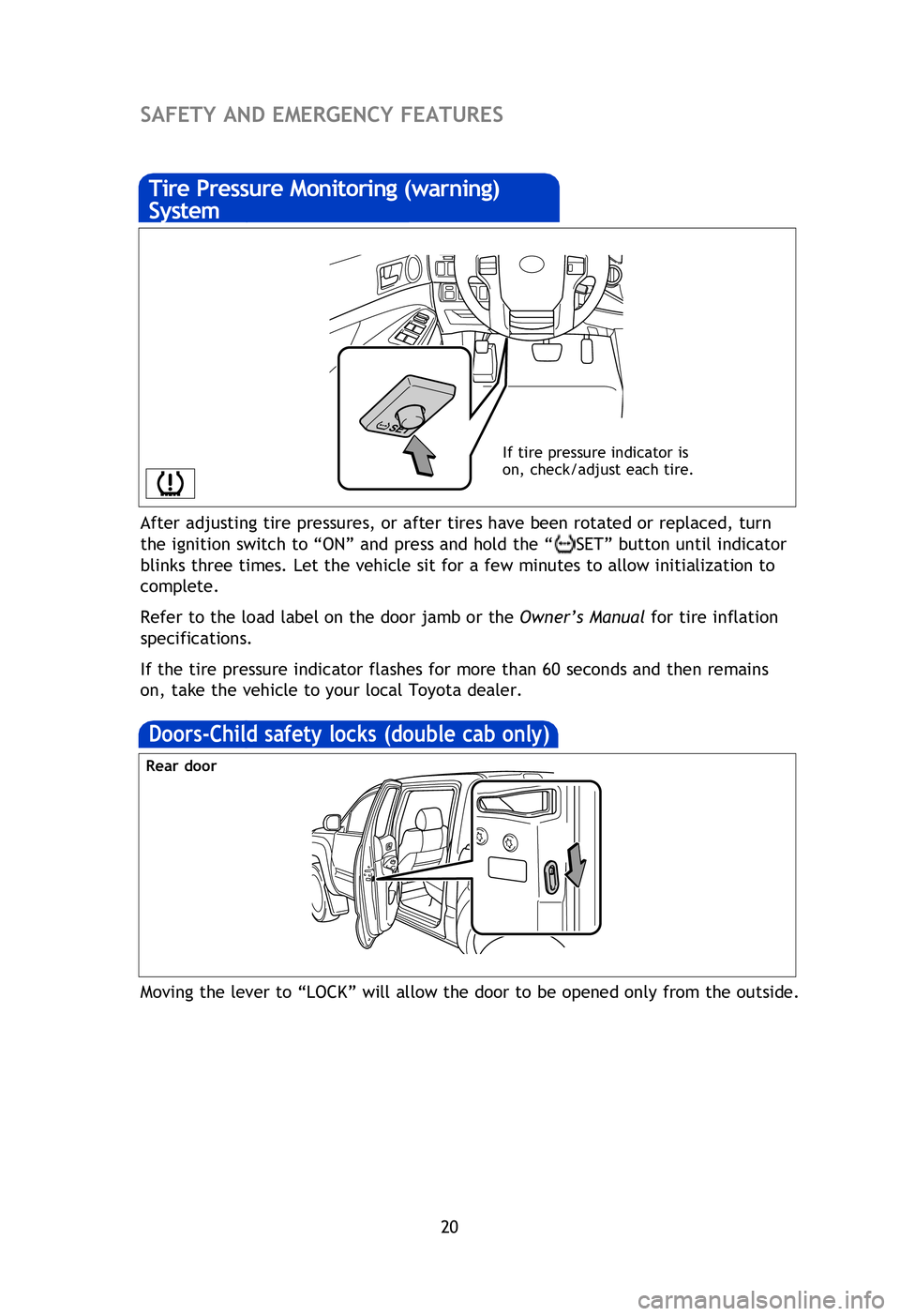
20
After adjusting tire pressures, or after tires have been rotated or replaced, turn
the ignition switch to “ON” and press and hold the “
SET” button until indicator
blinks three times. Let the vehicle sit for a few minutes to allow initialization to
complete.
Refer to the load label on the door jamb or the Owner’s Manual for tire inflation
specifications.
If the tire pressure indicator flashes for more than 60 seconds and then remains
on, take the vehicle to your local Toyota dealer.
Tire Pressure Monitoring (warning)
System
If tire pressure indicator is
on, check/adjust each tire.
Spare tire & tools
Tool location
Removing the spare tire
(1) Assemble the jack handle.
(2) Insert the jack handle end into the lowering screw.
(3) Turn the jack handle counterclockwise.
Refer to the Owner’s Manual for tire changing and jack positioning procedures.
Regular cab models
-behind the seatback
Moving the lever to “LOCK” will allow the door to be opened only from the outside.
Doors-Child safety locks (double cab only)
Rear door
SAFETY AND EMERGENCY FEATURES
(1)
126906_GUTS.indd 207/20/12 10:51 PM
Page 23 of 28
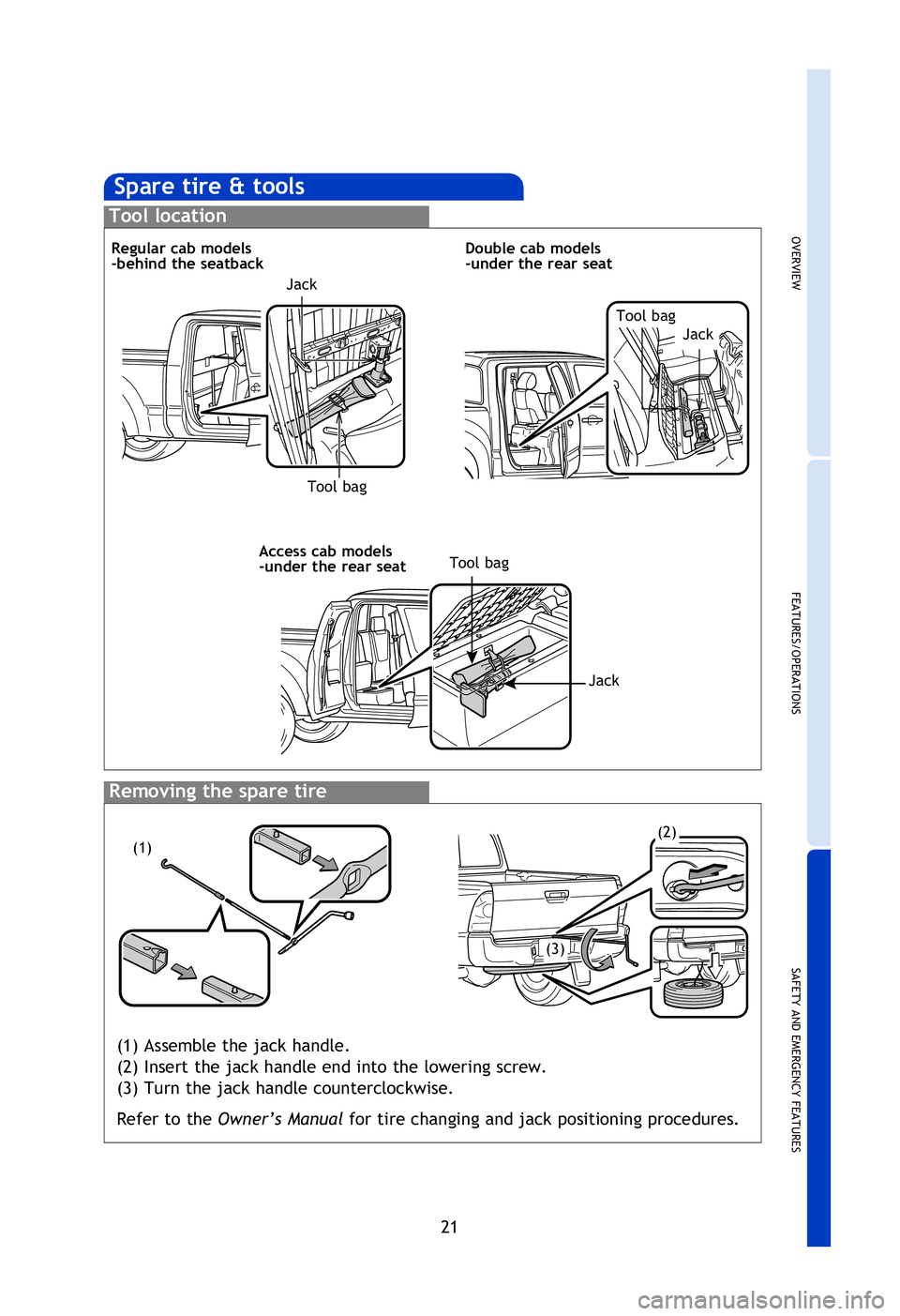
OVERVIEW
FEATURES/OPERATIONS
SAFETY AND EMERGENCY FEATURES
21
After adjusting tire pressures, or after tires have been rotated or replaced, turn
the ignition switch to “ON” and press and hold the “SET” button until indicator
blinks three times. Let the vehicle sit for a few minutes to allow initialization to
complete.
Refer to the load label on the door jamb or the Owner’s Manual for tire inflation
specifications.
If the tire pressure indicator flashes for more than 60 seconds and then remains
on, take the vehicle to your local Toyota dealer.
Spare tire & tools
Tool location
Removing the spare tire
(1) Assemble the jack handle.
(2) Insert the jack handle end into the lowering screw.
(3) Turn the jack handle counterclockwise.
Refer to the Owner’s Manual for tire changing and jack positioning procedures.
Regular cab models
-behind the seatback Double cab models
-under the rear seat
Access cab models
-under the rear seatTool bag
Jack
Tool bagJack
Tool bag
Jack
Moving the lever to “LOCK” will allow the door to be opened only from the outside.
(1)
(3)
(2)
126906_GUTS.indd 217/20/12 10:51 PM
Page 24 of 28
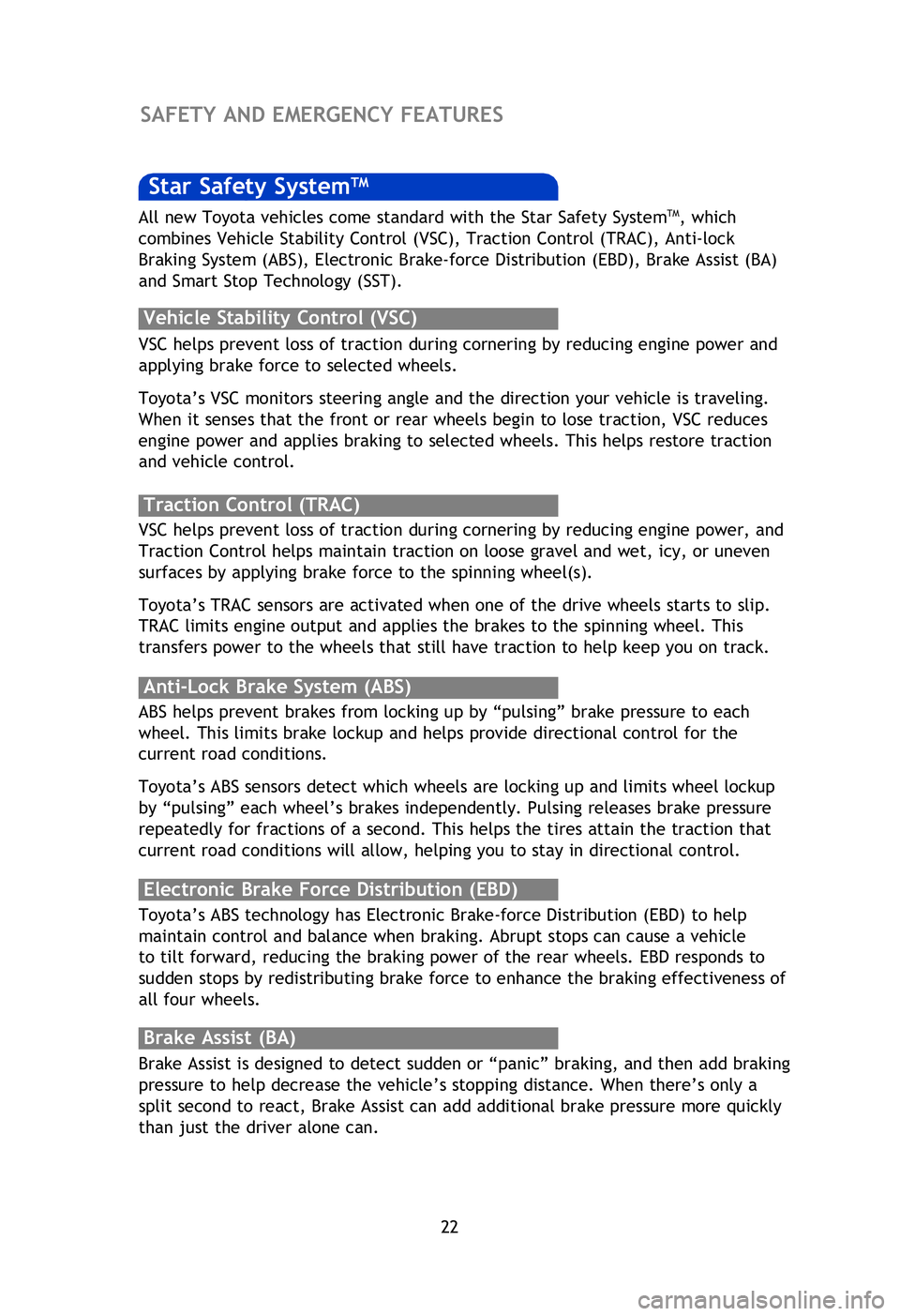
22
There are two types of Toyota floor mats: carpeted and all-weather. Each vehicle
has model-specific floor mats. Installation is easy.
To keep your floor mat properly positioned, follow these steps:
• Only use floor mats designed for your specific model.
• Use only one floor mat at a time, using the retaining hooks to keep the mat in
place.
• Install floor mats right side up.
Floor mat installation
SAFETY AND EMERGENCY FEATURES
Smart Stop Technology automatically reduces engine power when the accelerator
and brake pedals are pressed simultaneously under certain conditions.
SST engages when the accelerator is depressed first and the brakes are applied
firmly for longer than one-half second at speeds greater than five miles per hour.
SST doesn’t engage if the brake pedal is depressed before the accelerator pedal,
allowing vehicles to start on a steep hill and safely accelerate without rolling
backward.
Smart Stop Technology (SST)Star Safety SystemTM
VSC helps prevent loss of traction during cornering by reducing engine power and
applying brake force to selected wheels.
Toyota’s VSC monitors steering angle and the direction your vehicle is traveling.
When it senses that the front or rear wheels begin to lose traction, VSC reduces
engine power and applies braking to selected wheels. This helps restore traction
and vehicle control.
Vehicle Stability Control (VSC)
Anti-Lock Brake System (ABS)
ABS helps prevent brakes from locking up by “pulsing” brake pressure to each
wheel. This limits brake lockup and helps provide directional control for the
current road conditions.
Toyota’s ABS sensors detect which wheels are locking up and limits wheel lockup
by “pulsing” each wheel’s brakes independently. Pulsing releases brake pressure
repeatedly for fractions of a second. This helps the tires attain the traction that
current road conditions will allow, helping you to stay in directional control.
Brake Assist (BA)
Brake Assist is designed to detect sudden or “panic” braking, and then add braking
pressure to help decrease the vehicle’s stopping distance. When there’s only a
split second to react, Brake Assist can add additional brake pressure more quickly
than just the driver alone can. VSC helps prevent loss of traction during cornering by reducing engine power, and
Traction Control helps maintain traction on loose gravel and wet, icy, or uneven
surfaces by applying brake force to the spinning wheel(s).
Toyota’s TRAC sensors are activated when one of the drive wheels starts to slip.
TRAC limits engine output and applies the brakes to the spinning wheel. This
transfers power to the wheels that still have traction to help keep you on track.
Traction Control (TRAC)
Electronic Brake Force Distribution (EBD)
Toyota’s ABS technology has Electronic Brake-force Distribution (EBD) to help
maintain control and balance when braking. Abrupt stops can cause a vehicle
to tilt forward, reducing the braking power of the rear wheels. EBD responds to
sudden stops by redistributing brake force to enhance the braking effectiveness of
all four wheels. All new Toyota vehicles come standard with the Star Safety System
TM, which
combines Vehicle Stability Control (VSC), Traction Control (TRAC), Anti-lock
Braking System (ABS), Electronic Brake-force Distribution (EBD), Brake Assist (BA)
and Smart Stop Technology (SST).
126906_GUTS.indd 227/20/12 10:51 PM
Page 25 of 28
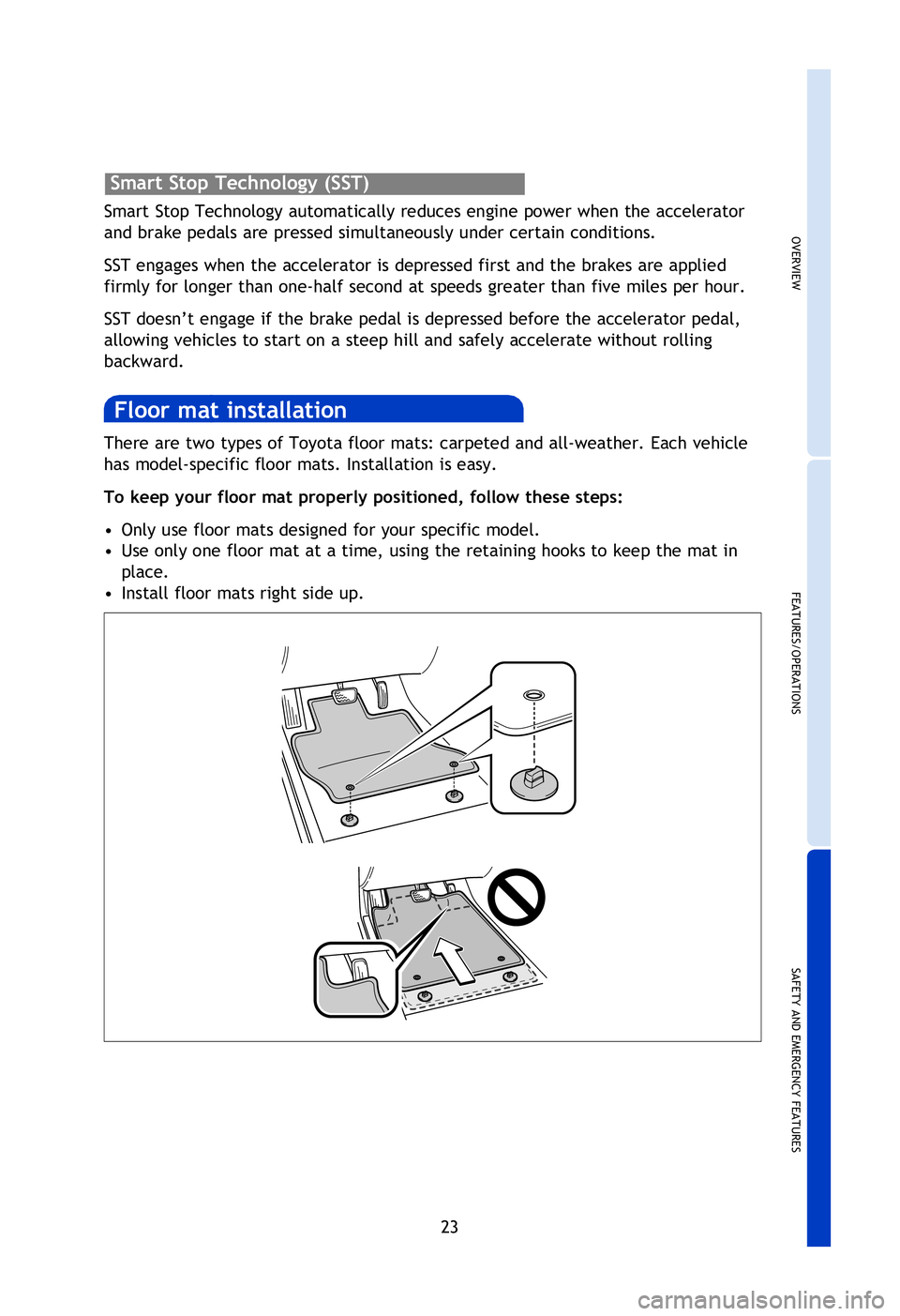
OVERVIEW
FEATURES/OPERATIONS
SAFETY AND EMERGENCY FEATURES
23
There are two types of Toyota floor mats: carpeted and all-weather. Each vehicle
has model-specific floor mats. Installation is easy.
To keep your floor mat properly positioned, follow these steps:
•
Only use floor mats designed for your specific model.
• Use only one floor mat at a time, using the retaining hooks to keep the mat in
place.
• Install floor mats right side up.
Floor mat installation
SAFETY AND EMERGENCY FEATURES
Smart Stop Technology automatically reduces engine power when the accelerator
and brake pedals are pressed simultaneously under certain conditions.
SST engages when the accelerator is depressed first and the brakes are applied
firmly for longer than one-half second at speeds greater than five miles per hour.
SST doesn’t engage if the brake pedal is depressed before the accelerator pedal,
allowing vehicles to start on a steep hill and safely accelerate without rolling
backward.
Smart Stop Technology (SST)
VSC helps prevent loss of traction during cornering by reducing engine power and
applying brake force to selected wheels.
Toyota’s VSC monitors steering angle and the direction your vehicle is traveling.
When it senses that the front or rear wheels begin to lose traction, VSC reduces
engine power and applies braking to selected wheels. This helps restore traction
and vehicle control.
ABS helps prevent brakes from locking up by “pulsing” brake pressure to each
wheel. This limits brake lockup and helps provide directional control for the
current road conditions.
Toyota’s ABS sensors detect which wheels are locking up and limits wheel lockup
by “pulsing” each wheel’s brakes independently. Pulsing releases brake pressure
repeatedly for fractions of a second. This helps the tires attain the traction that
current road conditions will allow, helping you to stay in directional control.
Brake Assist is designed to detect sudden or “panic” braking, and then add braking
pressure to help decrease the vehicle’s stopping distance. When there’s only a
split second to react, Brake Assist can add additional brake pressure more quickly
than just the driver alone can. VSC helps prevent loss of traction during cornering by reducing engine power, and
Traction Control helps maintain traction on loose gravel and wet, icy, or uneven
surfaces by applying brake force to the spinning wheel(s).
Toyota’s TRAC sensors are activated when one of the drive wheels starts to slip.
TRAC limits engine output and applies the brakes to the spinning wheel. This
transfers power to the wheels that still have traction to help keep you on track.
Toyota’s ABS technology has Electronic Brake-force Distribution (EBD) to help
maintain control and balance when braking. Abrupt stops can cause a vehicle
to tilt forward, reducing the braking power of the rear wheels. EBD responds to
sudden stops by redistributing brake force to enhance the braking effectiveness of
all four wheels. All new Toyota vehicles come standard with the Star Safety System
TM, which
combines Vehicle Stability Control (VSC), Traction Control (TRAC), Anti-lock
Braking System (ABS), Electronic Brake-force Distribution (EBD), Brake Assist (BA)
and Smart Stop Technology (SST).
126906_GUTS.indd 237/20/12 10:51 PM